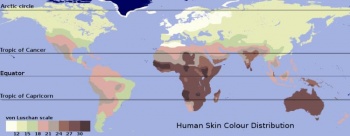A human race is a variety of humans (Homo sapiens), distinguished by features such as skin color, facial appearance, shape of skull, type of hair and height. Races have generally been defined by some easily distinguished external feature.
There have been various different accounts of racial origins. Some have led to racist attitudes, by which people attempt to characterise other races than their own as inferior.
The differences between human races are assumed to arise in the same way as variations of other kinds of plants or animals. Separation will potentially lead to divergence that would theoretically lead to the formation of separate species.
When evolution was first propounded as a theory of origins, it was almost universally assumed that different races were the product of evolution. Evolutionists applied the myth of progressive development and concluded that the white race was the pinnacle of evolutionary development and that other human races were less-evolved precursors of it. This was perhaps fed by a desire to justify their racist attitudes to coloured people, particularly since racism was used to justify slavery.
Modern evolutionists deny that evolution supports racism, but this is more because racist ideas have become politically incorrect than because they cannot be derived from evolutionary theory.

All people now alive are descended from the three sons of Noah and their wives, and ultimately from the first humans, Adam and Eve, who were directly created by God. The sons of Noah were alive around 4,500 years ago, and all human races have been derived from them. The Bible relates how their children founded various nations, which have spread out into various regions of the world.
After the flood of Noah, people stayed in one area until God confused their languages at the Tower of Babel. This event induced the human population to separate into distinct groups, which dispersed across the world. In general, the sons of Shem gave birth to nations which include the Hebrews, Arabs, Assyrians, Persians, Syrians and others. The Hamites have included such great empires as Sumeria, Phoenicia, Egypt, Ethiopia, etc., and quite possibly the great Asian nations (China, Japan, etc.). The Japhetic peoples include the Greeks, Romans, Aryans, Europeans.[1]
Migration of the various language groups into different parts of the world, natural selection of the separated gene pools induced rapid genetic drift. The disjunct populations quickly became distinguished by particular characteristics that were regionally favorable. Jonathan Sarfati comments on the effects of Babel in his book Refuting Evolution 2
| “ | Babel resulted in the isolation of small people groups, each containing a fraction of the total gene pool. This would help fix certain characteristics. Natural selection and sexual selection would act on these, producing the different people groups (‘races’) we see today.[2] | ” |
For example, people with a significant tendency to produce melanin in their skin prospered better in the equatorial regions of the world, where the trait gave them protection against UV radiation. These same groups were also naturally selected to have smaller body sizes and longer extremities to aid in heat dissipation. Likewise the groups who traveled a significant distance from the equator have less melanin, and increased production of vitamin D in the weaker sunlight. In addition, humans living in cooler climates were selected to have larger body sizes and smaller extremities to prevent a loss of body heat. In this way, the various races came into being in a very short time. The speed at which these distinguishing characteristics developed adequately illustrates that any claims of superiority based on these differences are quite unfounded. Sarfati comments further:
| “ | Also, some people groups would be isolated from civilization. Consider even the typical small extended family group today, if suddenly isolated from civilization, e.g., on a desert island. Many such groups would not have the ability to smelt metals or build houses. Therefore, they would have to use the hardest material available (stone) and make use of already-existing structures (caves). Different family groups would also have different levels of artistic ability. So it shouldn’t be too difficult to accept that humans such as Homo erectus and Neandertals were probably post-Babel humans who became isolated from major cities, and developed certain physical characteristics because certain genes became fixed due to the small population and selective factors. The notion of a ‘stone age’ is fallacious—rather, it’s a cave/stone technology stage of different people groups. Some people even today have this level of technology, but they live at the same time as us, and are just as human.[3] | ” |
Aryan is a term used to denote an ethno-linguistic collection of peoples united as native speakers of the same Indo-Aryan branch of the Indo-Iranian family of Indo-European languages.
A very controversial topic immediately adopting an occult stigma when it was written about as a root-race by Helena Blavatsky (1831–1891) and debated within the Theosophical movement of which she is one of the four original founders. She declared all other races essentially inferior or a lesser human physically and spiritually. These tenets of theosophy are said by Blavatsky to be derived from Far East teachings of Buddhism and Hinduism. Theosophy today in the 21st century is an integral part of the New Age movement.
Another historical time that tried to define the Aryan race was that of the Nazi expansion. The idea that original speakers of the parent language of the Indo-European languages and their immediate descendants until the modern era embody a distinctive Caucasian race. In other words a sub-race of Caucasians were the first native speakers of the Proto-Indo-European language according to Nazi propaganda. Nazism claims the Vedic Aryans of Northern India are ethnically identical to Goths, Vandals and other ancient Germanic peoples.[Reference needed]
|
||||||||||||||||||||